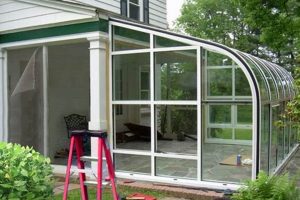A device comprised of electronic components and instructions that enables individuals to construct their own audio amplification system. This often includes a printed circuit board (PCB), resistors, capacitors, transistors, and a detailed manual to guide the user through the assembly process. An example includes a kit that allows a user to build a small headphone amplifier from scratch.
Building one’s own amplifier fosters a deeper understanding of electronics and audio engineering. Such projects cultivate problem-solving skills and offer a cost-effective entry point into high-fidelity audio. Historically, these types of electronics projects were common in vocational education and have experienced a resurgence among hobbyists and enthusiasts seeking hands-on experience.
The following sections will delve into the selection criteria, assembly techniques, and troubleshooting tips essential for a successful amplifier construction project.
DIY Amplifier Kit Assembly
Successful construction demands careful planning and execution. Adherence to the following guidelines significantly increases the likelihood of a functional and satisfying project.
Tip 1: Component Identification and Organization: Before commencing assembly, meticulously identify and organize all components. Utilizing a parts list and confirming each component’s value with a multimeter prevents errors. Grouping similar components into labeled containers streamlines the process.
Tip 2: Soldering Proficiency: Employ correct soldering techniques. A clean soldering iron tip, appropriate solder type (typically rosin-core), and controlled application of heat are critical. Inspect each solder joint for a smooth, shiny finish, indicating a solid electrical connection. Cold solder joints, characterized by a dull, grainy appearance, should be reflowed.
Tip 3: PCB Inspection: Thoroughly inspect the printed circuit board for any defects prior to component placement. Look for broken traces, shorts, or contamination. Clean the board with isopropyl alcohol if necessary.
Tip 4: Polarity Awareness: Exercise extreme caution when installing polarized components such as electrolytic capacitors and diodes. Reverse polarity can lead to component failure and potential damage to the circuit. Double-check the orientation against the schematic and component markings.
Tip 5: Grounding Practices: Implement proper grounding techniques. A solid ground plane reduces noise and ensures stable operation. Ensure all ground connections are secure and free from impedance.
Tip 6: Voltage Considerations: Prior to applying power, verify the voltage ratings of all components. Exceeding these ratings can result in catastrophic failure.
Tip 7: Schematic Adherence: Strictly follow the schematic diagram. Even minor deviations can introduce errors and prevent the amplifier from functioning correctly.
Tip 8: Testing and Troubleshooting: After assembly, perform thorough testing with a multimeter to verify correct voltages and continuity. If the amplifier does not function as expected, systematically troubleshoot the circuit using the schematic and a logical approach. Refer to online resources and forums for assistance.
Diligent application of these tips leads to a more reliable and enjoyable amplifier building experience. Attention to detail and adherence to best practices are paramount.
The subsequent section will explore common troubleshooting scenarios encountered during amplifier construction and their respective solutions.
1. Component Selection
Component selection represents a foundational element in the successful assembly and performance of a do-it-yourself (DIY) amplifier kit. The quality and specifications of individual components directly influence the amplifier’s sonic characteristics, power output, stability, and overall lifespan. For instance, the choice of output transistors dictates the maximum power the amplifier can deliver without distortion. Similarly, the type of capacitors used in the signal path affects the frequency response and tonal coloration of the amplified signal. Substituting generic resistors with precision metal film resistors in critical areas can reduce noise and improve signal-to-noise ratio.
Furthermore, component selection impacts the reliability of the finished amplifier. Undersized or low-quality components are more susceptible to failure under stress, potentially leading to performance degradation or complete amplifier malfunction. Real-world examples include amplifiers employing electrolytic capacitors with insufficient voltage ratings, which can bulge or rupture over time, causing circuit instability and potential damage to other components. Conversely, over-specifying components increases cost without necessarily providing a significant performance improvement, thus highlighting the importance of balanced and informed decision-making.
In conclusion, meticulous component selection is not merely a technical detail but a crucial determinant of the final amplifier’s performance and longevity. A comprehensive understanding of component specifications, performance characteristics, and their interaction within the circuit is paramount for achieving optimal results from a amplifier kit. Inadequate consideration can lead to compromised sound quality, reduced reliability, and ultimately, a less satisfying amplifier-building experience.
2. Circuit Understanding
Effective construction of a do-it-yourself (DIY) amplifier kit necessitates a fundamental understanding of circuit principles. This knowledge base dictates the builder’s ability to accurately interpret schematic diagrams, identify component functions, and anticipate the effects of component variations on the overall amplifier performance. For example, a builder lacking knowledge of operational amplifier (op-amp) gain configurations may inadvertently introduce oscillations or clipping by selecting inappropriate resistor values in the feedback network. Similarly, an inadequate grasp of power supply regulation can lead to instability and noise in the amplified signal. Without this foundation, the kit becomes a collection of disparate components assembled according to rote instructions, rather than a cohesive electronic system under the builder’s control.
The practical application of circuit understanding manifests throughout the assembly process. Accurate placement of components hinges on interpreting the circuit diagram; correct soldering depends on visualizing the electrical connections; and effective troubleshooting demands a systematic approach based on circuit analysis. A builder familiar with Ohm’s Law can readily calculate resistor values needed for a specific voltage divider circuit, while one versed in transistor biasing can diagnose and correct distortion issues stemming from improper transistor operating points. Furthermore, this u
nderstanding fosters the ability to modify or customize the amplifier circuit to suit specific needs or preferences. A user wanting to alter the gain of the amplifier could easily do so, provided the understanding of the circuitry allows him to identify the relevant components.
In summary, a working knowledge of circuit principles is not merely beneficial but crucial to the successful completion and effective utilization of a amplifier kit. It empowers the builder to move beyond simple assembly, enabling informed decision-making, effective troubleshooting, and potential customization of the device. The absence of circuit understanding transforms a potentially rewarding educational experience into a frustrating exercise in following instructions blindly. Embracing the circuit learning fosters deeper understanding of amplifier technologies which leads to a more successful build.
3. Soldering Technique
The functionality of a DIY amplifier kit hinges critically on proficient soldering technique. Soldering forms the physical and electrical connections between electronic components, creating the conductive pathways essential for signal flow and power distribution. Improper soldering introduces a multitude of problems, ranging from intermittent signal loss to complete circuit failure. For example, a “cold” solder joint, characterized by a dull, grainy appearance, exhibits high resistance and unreliable conductivity, potentially causing distortion or preventing the amplifier from functioning altogether. A poorly soldered ground connection can introduce noise into the audio signal, degrading the sound quality. The physical integrity of the solder joint is also crucial; a weak joint can fracture under stress, leading to intermittent operation or complete failure over time.
The practical significance of proper soldering extends beyond basic functionality. A well-executed solder joint maximizes the efficiency of the electrical connection, minimizing voltage drops and heat generation. This is particularly important in power amplifier stages, where high currents flow through critical components. Consistent application of heat and solder ensures uniform bonding, preventing the formation of voids or contaminants within the joint that could compromise conductivity. The appearance of the solder joint also provides a visual indicator of its quality. A smooth, shiny fillet indicates proper wetting and adherence to the component leads and circuit board pads. Experienced builders can often diagnose potential problems simply by observing the solder joints.
In summary, soldering technique is not merely a procedural step in constructing a amplifier kit; it is a fundamental determinant of the amplifier’s reliability, performance, and longevity. Mastering soldering techniques, including temperature control, solder application, and joint inspection, is therefore essential for any individual undertaking such a project. Inadequate attention to soldering quality will inevitably lead to operational issues and a compromised final product.
4. Safety Precautions
The construction and operation of a DIY amplifier kit necessitates strict adherence to safety precautions due to the inherent presence of potentially hazardous voltages and currents. Failure to observe these precautions can lead to severe electrical shock, burns, or even fatal consequences. Cause-and-effect relationships are direct and demonstrable: improper grounding can create a lethal shock hazard, while inadequate ventilation can cause overheating and fire. The importance of safety measures is paramount; it is an integral component of any responsible approach to building and using electronic devices, with the potential for serious personal injury existing if safeguards are not put in place. Real-life examples include instances of individuals receiving severe electrical burns from touching exposed terminals or suffering cardiac arrest due to electrical shock while working on ungrounded circuits.
Practical applications of safety protocols involve several key areas. First, ensuring that the amplifier is properly grounded minimizes the risk of electrical shock in the event of a fault. Second, utilizing a properly rated isolation transformer when working on live circuits prevents direct contact with the mains voltage. Third, exercising caution when handling high-voltage components, such as capacitors, even after the power supply has been disconnected, is essential. Finally, providing adequate ventilation around the amplifier prevents overheating, which can damage components and potentially cause a fire. Furthermore, the selection of appropriately rated fuses protects the amplifier and its power source from overcurrent conditions.
In summary, stringent implementation of safety precautions is not merely a suggestion but an absolute requirement for constructing and operating a DIY amplifier kit. Neglecting these precautions introduces significant risks of personal injury and property damage. A thorough understanding of potential hazards and the corresponding safety measures is essential for anyone undertaking such a project. The challenge lies in fostering a culture of safety consciousness within the DIY electronics community, ensuring that all individuals prioritize safe practices above all else. This commitment safeguards individuals and promotes the responsible development and application of electronics.
5. Troubleshooting Skills
The successful completion of a DIY amplifier kit project often relies heavily on the builder’s troubleshooting skills. The complexity of electronic circuits, combined with the potential for errors during assembly, makes the ability to diagnose and resolve problems an essential attribute.
- Component Identification and Validation
The ability to accurately identify and validate component values is critical. Misidentification or incorrect component placement is a common source of errors. For example, placing a resistor of the wrong value in a critical circuit location can significantly alter the amplifier’s gain or frequency response, leading to unexpected behavior. A builder must be able to use a multimeter to verify resistor, capacitor, and transistor parameters against the schematic.
- Signal Tracing and Measurement
Understanding how to trace signals through the amplifier circuit and measure voltage levels at key test points is essential for isolating faults. The ability to use an oscilloscope to visualize signal waveforms allows the builder to identify distortion, noise, or signal loss that may be indicative of component failure or wiring errors. This process often involves comparing measured values against expected values from the schematic or from known working examples.
- Fault Isolation Techniques
A systematic approach to fault isolation is necessary for efficiently identifying the root cause of a problem. This might involve dividing the circuit into functional blocks and testing each block independently to narrow down the source of the issue. It also requires understanding how different components interact and how a failure in one part of the circuit can affect the behavior of other parts. For example, a shorted capacitor in the power supply ca
n cause voltage sags that affect the entire amplifier. - Schematic Interpretation and Documentation Review
The ability to interpret schematic diagrams accurately and review provided documentation carefully is paramount. Errors in assembly often stem from misreading the schematic or overlooking important details in the instruction manual. A thorough understanding of circuit symbols, component designations, and circuit layouts is necessary for avoiding mistakes and identifying potential problem areas. A builder must be able to correlate the schematic with the physical layout of the circuit board.
In conclusion, robust troubleshooting skills are not merely a supplementary asset but rather a prerequisite for the successful construction and functional operation of a amplifier kit. Developing proficiency in these areas enhances the builder’s understanding of electronics and increases the likelihood of a positive outcome. The acquired skills often extend beyond the realm of amplifier construction, proving valuable in various other electronics projects and repairs.
Frequently Asked Questions about DIY Amplifier Kits
This section addresses common inquiries regarding the selection, assembly, and operation of do-it-yourself (DIY) amplifier kits.
Question 1: What level of electronics experience is required to assemble a DIY amplifier kit?
While some kits are designed for beginners with minimal electronics knowledge, most projects require at least a basic understanding of circuit diagrams, component identification, and soldering techniques. Complex kits may demand familiarity with amplifier topologies and troubleshooting methodologies.
Question 2: What tools are essential for assembling a DIY amplifier kit?
A soldering iron with a fine tip, solder, wire cutters, wire strippers, pliers, a multimeter, and a magnifying glass are considered essential tools. Depending on the kit, additional tools such as desoldering equipment, heat shrink tubing, and a drill may be necessary.
Question 3: How can potential safety hazards be mitigated during the assembly and testing process?
Safety glasses should be worn at all times. The amplifier should be assembled in a well-ventilated area. Ensure the power supply is disconnected before making any modifications or measurements. A multimeter with appropriate voltage ratings should be used, and caution should be exercised when working with high voltages.
Question 4: What are some common mistakes made during DIY amplifier kit assembly?
Common mistakes include incorrect component placement, cold solder joints, shorts between traces, and improper wiring. Careful attention to the schematic diagram and thorough inspection of solder joints can minimize these errors.
Question 5: How does component selection impact the performance of a DIY amplifier?
Component selection significantly impacts amplifier performance. Higher-quality components, such as precision resistors and low-noise operational amplifiers, can improve signal-to-noise ratio, reduce distortion, and enhance the overall sound quality. Specifications of the chosen components, such as voltage and current ratings, should always be observed to avoid failure.
Question 6: What troubleshooting steps should be taken if the amplifier does not function correctly after assembly?
Begin by visually inspecting the circuit board for any obvious errors, such as missing components or solder bridges. Then, use a multimeter to check for proper voltage levels at key test points. Signal tracing with an oscilloscope can help isolate the source of the problem. Online forums and communities dedicated to DIY electronics can provide valuable support and troubleshooting advice.
Careful planning, precise execution, and a methodical approach to troubleshooting are paramount for the successful construction of a amplifier kit. These questions and answers provided may help the understanding and construction of a amplifier kit.
The subsequent section provides resources for those seeking assistance in their amplifier building projects.
Conclusion
The preceding discussion has explored various facets of the diy amplifier kit, from component selection and soldering techniques to safety precautions and troubleshooting methodologies. Successful completion of such a project demands a combination of technical knowledge, meticulous execution, and a commitment to safety. The amplifier kit, while offering an avenue for learning and personal fulfillment, presents challenges that require a thoughtful and disciplined approach.
Individuals contemplating engagement with a diy amplifier kit should carefully assess their existing skill set and be prepared to invest the necessary time and effort. The potential rewardsa deeper understanding of electronics and a custom-built audio amplifierare significant, but they are contingent upon a serious and informed commitment to the endeavor.







